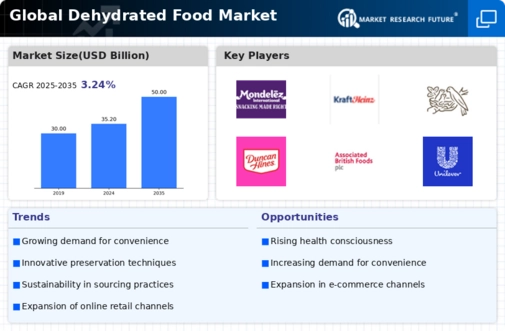Market Growth Projections
The Global Global Dehydrated Food Market Industry is poised for substantial growth, with projections indicating a market size of 35.2 USD Billion in 2024 and a potential increase to 50 USD Billion by 2035. This growth trajectory suggests a compound annual growth rate of 3.24% from 2025 to 2035, reflecting increasing consumer interest in dehydrated food products. Factors such as rising health consciousness, demand for convenience, and advancements in food processing technologies contribute to this positive outlook. The market's expansion is likely to create opportunities for innovation and diversification within the industry.
Global Supply Chain Improvements
Improvements in global supply chains significantly impact the Global Global Dehydrated Food Market Industry. Enhanced logistics and distribution networks facilitate the efficient movement of dehydrated products across regions, ensuring availability in diverse markets. This accessibility is crucial as consumer demand for dehydrated foods rises. As supply chains become more streamlined, companies can reduce costs and improve product availability, thereby fostering market growth. The anticipated increase in market size to 50 USD Billion by 2035 may be partially attributed to these supply chain enhancements, which support the industry's expansion.
Rising Demand for Convenience Foods
The Global Global Dehydrated Food Market Industry experiences a notable surge in demand for convenience foods, driven by changing consumer lifestyles. As urbanization continues to rise, individuals seek quick meal solutions that do not compromise on nutrition. Dehydrated foods, which offer extended shelf life and ease of preparation, align perfectly with this trend. In 2024, the market is projected to reach 35.2 USD Billion, reflecting a growing preference for ready-to-eat options. This shift is particularly evident in regions with busy urban populations, where the need for efficient meal solutions is paramount.
Health Consciousness Among Consumers
Increasing health consciousness among consumers significantly influences the Global Global Dehydrated Food Market Industry. As individuals become more aware of the nutritional value of their food, they gravitate towards products that offer health benefits. Dehydrated foods, often retaining essential nutrients, cater to this demand. The market is likely to expand as consumers seek alternatives to processed foods, which are often high in preservatives and additives. This trend is expected to contribute to the market's growth, with projections indicating a rise to 50 USD Billion by 2035, as health-oriented consumers prioritize quality and nutrition.
Sustainability and Environmental Concerns
Sustainability and environmental concerns are increasingly influencing the Global Global Dehydrated Food Market Industry. As consumers become more environmentally conscious, they seek products that align with sustainable practices. Dehydrated foods, which often require less water and energy for production compared to fresh counterparts, present a more sustainable option. This shift towards eco-friendly products is likely to drive market growth, as companies adopt sustainable sourcing and production methods. The industry's commitment to sustainability could enhance its appeal, potentially attracting a broader consumer base and contributing to the projected market growth.
Technological Advancements in Food Processing
Technological advancements in food processing play a crucial role in shaping the Global Global Dehydrated Food Market Industry. Innovations in dehydration techniques enhance the quality and flavor of dehydrated products, making them more appealing to consumers. For instance, advancements in freeze-drying and spray-drying technologies improve nutrient retention and taste, thereby increasing market competitiveness. As these technologies evolve, they may lead to a broader range of dehydrated food options, catering to diverse consumer preferences. This evolution is likely to support a compound annual growth rate of 3.24% from 2025 to 2035, indicating a robust future for the industry.






















Leave a Comment